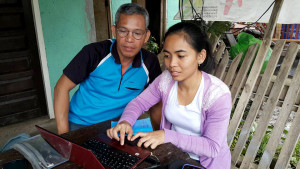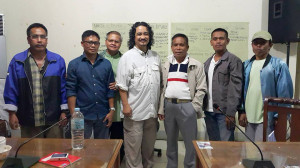Queenie Liwat grew up listening for gunfire.1 In her hometown of Banisilan, North Cotabato, she and her friends learned from an early age how to survive in a warzone. “Whenever there are gunshots, even if we are afraid, we have to be brave and alert, or else we will die like the others. There’s only two things you can do: hide and wait for death or fight back waiting for death.” She was eight years old when she first witnessed combat on the outskirts of her town. “We were at first delighted to see the planes above us. But we stopped playing when we heard the sound of [bombs] and can feel the earth shaking.” The kids ran to get a clearer view of the action taking place on the next hillside over. “We can see some men crawling that look like ants…and smoke too. What I felt at that time is a mixture of fear and anger and pity of the people on the other side.” In her grandfather’s basement there was a sandbagged hiding place. “My uncles would explain to us that we’ll be safe inside in case gunshots will be everywhere.”
Feuds between tribes, families, and political factions, along with the ongoing war between Moro rebels and the government of the Philippines, force the citizens of Banisilan to remain forever on guard, ready to fight or flee. Much of the tribal animosity has its roots in the centuries-long pattern of migration into Mindanao by Filipinos from the islands to the north. First Spanish and then American colonizers, and finally the Manila-based government of the Republic of the Philippines all encouraged Christianized Filipinos from Luzon and the Visayan Islands to relocate to Mindanao where good farmland was plentiful and, from a Western perspective, underexploited by the Muslim Moros and non-Islamized indigenous tribes who dwelt there. (Today, members of the non-Islamized tribes are known collectively as Lumads.)
Colonial and Filipino administrators aimed to make Mindanao more productive and to introduce its peoples to modern ways and codes of law. They also calculated that by planting colonies of loyal and relatively westernized Filipinos in Mindanao, they might strengthen the authority that the central government in Manila could exercise over the large southern island, whose indigenous residents had proved less manageable. Accordingly, deeds to plots of rich Mindanaoan land were for decades awarded to Visayan and Luzonian families willing to homestead in the hinterlands. The authorities billed Mindanao as “The Land of Promise”—a slogan you still hear occasionally.
Naturally, the native inhabitants of Mindanao considered their ancestral territory neither underused nor up-for-grabs. Many Christian Filipino homesteaders who migrated to Mindanao hoping to lift their families from poverty found instead a violent death at the hands of Moro warriors and hill tribesmen whose territorial claims were based on oral traditions and ancestral custom rather than on land titles awarded by government. They scoffed at the title deeds the Christian settlers showed them. The saying became “You keep the title; we’ll keep the land.” The Christians, with the weight of the government on their side, matched atrocity for atrocity. In the 1970s, as Moro Nationalist armies engaged the Philippine military in large-scale war, Christian, Muslim, and Lumad civilian militias patrolled their own respective turfs. The government supplied arms to Christian paramilitary organizations such as the Ilaga, who became infamous for massacring Muslim villagers and mutilating the dead. Horrific acts on both sides of the conflict planted bitter hatreds that one generation passed to the next and fresh outrages reinforced. Since the 70’s, the war has repeatedly flared up and died down again. Some Moro rebels have signed peace agreements with the government, while others continue to fight. And, all the while, a robust communist insurgency occasions many additional armed encounters in the Mindanaoan back country, as leftist guerillas recruit among the disenfranchised Lumads. For hundreds of thousands of Mindanaoans, like the Christian, Muslim, and Lumad residents of Queenie’s hometown, there is no closure to the conflicts. Old wounds and contesting land ownership claims continue to pit neighbor against neighbor.
In a town where any day may bring a firefight, Queenie’s father is a man of peace. Jovito Liwat Jr. is a pastor and farmer with mixed Moro, Lumad, and Migrant ancestry. During Queenie’s childhood, their home was the only one she knew of where no guns were kept, and the Liwat children were forbidden from handling and practicing with guns as their cousins did. Jovito befriended his Muslim farmhands and would give them extra financial help when he could.
When Queenie graduated high school, she left North Cotabato to attend university in neighboring Bukidnon Province. There she befriended Clay and June Rojo, directors of the Bukidnon branch of PeaceBuilders Community, Inc. (PBCI), a Mennonite peace and justice consultancy founded by Mennonite Church Canada Witness workers Rev. Dann and Joji Pantoja. Queenie began to assist the Rojos as they conducted Peace and Reconciliation (PAR) outreaches in provincial towns and villages that had requested these conflict transformation workshops. Before long, Queenie was a dedicated PAR volunteer, cheerfully riding for hours through the choking dust of Bukidnon’s back roads in the jolting bed of the Rojos’ half-cab. In remote tribal outposts she saw long-held hatreds melt away during dialogue sessions between formerly mortal enemies. She thought about the lethal bitterness between the factions in her own hometown and wondered whether Banisilan’s opposing parties could ever be brought to sit down together.
In October of 2014 Queenie was back in Banisilan spending some days with her family. As she traded news with the town’s vice mayor, a Liwat family friend, he asked what was keeping her busy over in the neighboring province. She told him about the conflict transformation work in Bukidnon and how she had become an apostle of Peace And Reconciliation as she watched grim animosities defused in that province. The vice mayor agreed that Banisilan dearly needed such a dialogue, and he began plotting with Queenie how to make it happen. Jovito Liwat’s friendships on all sides of the conflict enabled him to summon elders and leaders of the warring communities to a meeting. Queenie asked the Rojos to come to Banisilan and conduct a PAR workshop, even though North Cotabato is outside of their designated mission field in the Bukidnon uplands.
As the scheduled meeting of the adversaries approached, the trauma of Queenie’s childhood and adolescence welled back up in her. She remembered how each time she saw the army trucks rolling and the soldiers in battle gear it meant early curfews for everyone and sleepless nights for family members who had to keep watch. High school proms were held as early as 1:00 pm so that everyone could be at home behind locked doors before dark, and they were subdued events with none of the exuberant dance music so essential to Filipino parties. Noise levels had to be kept low so that everyone could listen for approaching gunfire. As Queenie helped the Rojos make the final preparations for the workshop, she offered silent prayers for the safety of these missionaries who had come to Banisilan at her urging.
On the morning of November 27, 2014 the Muslim, Lumad and Christian community leaders assembled for the first seminar of the PAR curriculum—Rev. Dann Pantoja’s adaptation of Anabaptist principles to the culturally and religiously diverse atmosphere of the Philippines. PAR introduces peace theology according to the “Four Harmonies”: “harmony with the Creator— spiritual transformation; harmony with our being—psycho-social transformation; harmony with others—socio-political transformation; harmony with the Creation—economic-ecological transformation.” The program points all conflicting factions toward the basic values for which all can agree to work. That morning, as the Rojos began their presentation, the atmosphere in the meeting hall was, as Queenie puts it, “quite reserved.” It had been decades since the opposed parties in Banisilan’s conflicts had met, shared a meal, and talked with one another. But, as the day’s program went forward, the Muslim imams and ustads (religious instructors), the Evangelical pastors, the Catholic priest, and the Lumad spiritual leaders took part with growing enthusiasm. They heard one another’s historical narratives and grievances. It was clear that everyone was thoroughly weary of war. Queenie believes that God prepared the hearts of the leaders and made them receptive that day. Their discussions gave birth to the Banisilan Religious Affairs Society (BRAS) composed of leaders from all sides and sponsored by the Banisilan local government.
Now the elders of the town’s ethnic and religious factions are building mutual trust and have a regular forum for discussing the grievances of one group against another. The future peace of Banisilan depends on this sort of regular communication. In the past, what Queenie calls “incomplete news drifting around the town,” has occasioned bloodshed time and again. Last month, PBCI returned to Banisilan to give a follow-up PAR seminar to the BRAS membership. This time the Pantojas accompanied Queenie and the Rojos to the Banisilan municipal offices where thirty religious leaders gathered for another session of dialogue. These people are not exactly friends with one another yet. Rev. Dann sensed that some fear and tension were still present as they interacted. Yet they continue to prove willing to gather together and pursue reconciliation. A year ago most people would have judged this kind of respectful cooperation impossible.
The wounds left in Queenie’s heart and mind during her childhood in the warzone are finally mending now, as she participates in the dialogues in Banisilan. She once harbored intense anger towards Muslims. “I became prejudiced to them. I labeled them as heartless straightaway without researching about their thoughts and identity. It was only during the PAR [workshops] that I heard the accounts regarding their culture, and their own side of the story.” She has let go of her anger now, and realizes that the Muslims have no more desire for war than do the Christians. “The fear and trauma of war are felt both by the innocent Moros and migrants.”
Footnotes
Jonathan Cranston is staff writer for PeaceBuilders Community, Inc. (PCBI), Mindanao, Philippines. An earlier version of this article appeared on http://peacebuilderscommunity.org.

